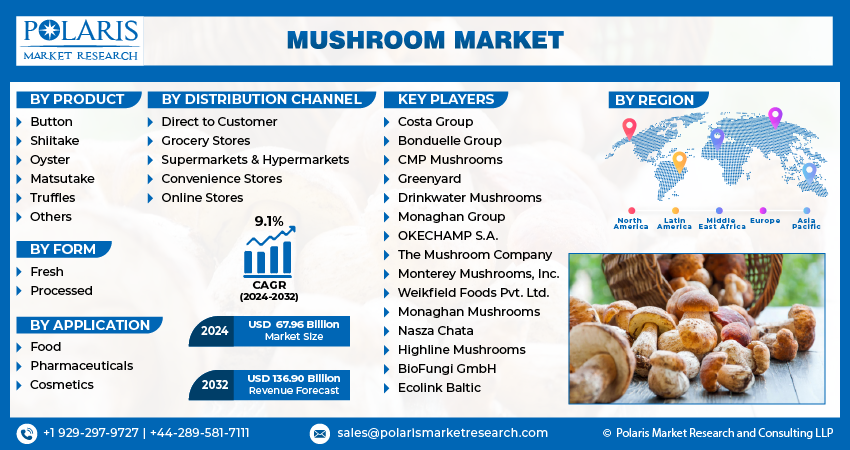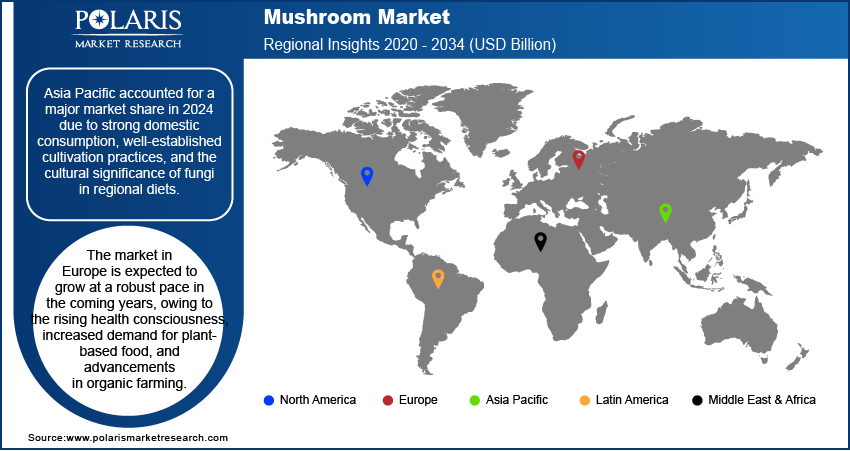
Mushroom Market Share, Size, Trends, Industry Analysis Report, By Product (Button, Shiitake, Oyster, Matsutake, Truffles); By Application; By Form; By End Use, By Distribution Channel; By Region; Segment Forecast, 2024 - 2032
- Published Date:Jan-2024
- Pages: 116
- Format: PDF
- Report ID: PM1953
- Base Year: 2023
- Historical Data: 2019-2022
Report Outlook
The global mushroom market size was valued at USD 62.31 billion in 2023. The market is anticipated to grow from USD 67.96 billion in 2024 to USD 136.90 billion by 2032, exhibiting the CAGR of 9.1% during the forecast period.
The growing vegan population's need for a high protein-rich diet is a significant driving force in the market. Several other factors projected to support the market include mushroom health benefits, increasing consumer awareness, growth of food industry, and innovations and product development in the last few years.

Know more about this report: Request for sample pages
Mushrooms are considered a high-nutrient food with low fat and calorie content and a great source of many important nutrients. Mushrooms are rich in vitamins and minerals such as vitamin D, B vitamins (niacin, riboflavin, pantothenic acid), selenium, copper, potassium, and phosphorus. It also contains antioxidants such as ergothioneine and glutathione, which help protect cells from damage caused by free radicals. Mushrooms are also a good source of dietary fiber, which can help improve digestion and promote feelings of fullness. Further, shiitake and maitake mushrooms contain beta-glucans that stimulate the immune system.
For instance, as per USDA, the mushroom sales for 2021 – 2022 in the United States were 702 million pounds worth 1.01 billion USD, while the total value of mushrooms sold in Canada rose 5.1% to $619.7 million in 2020.
The growing investment in smart automation in mushroom production further boosts the market. Smart automation refers to using advanced technologies such as robotics, artificial intelligence, and the Internet of Things (IoT) to improve the efficiency and productivity of mushroom farming.
Some ways that smart automation impacts the market include helping growers automate many of the manual tasks involved in mushroom farming, such as harvesting, sorting, and packaging, and reducing labor costs by automating many of the functions involved in mushroom farming. It also helps growers increase their production capacity, allowing them to grow more mushrooms in a shorter period. It can help them meet the growing demand for mushrooms in the global market.
The covid 19 pandemic has had a long-term positive impact on the mushroom market. Consumers' consumption patterns have changed manifold for several reasons and led to an increase in demand for mushrooms due to their perceived immune-boosting properties. Many people seek foods that can help support their immune systems, and mushrooms are believed to offer these benefits. Further, a shift from traditional to online buying behavior has been witnessed in the pandemic period, and some mushroom growers have also shifted their focus to online sales channels to reach customers directly.
While the pandemic has also hampered the market in a short term owing to factors such as the disruption of supply chains and the closure of restaurants. The pandemic is characterized by supply chain disruptions, making it difficult for some growers to get their products to market. It has resulted in shortages and higher prices for certain types of mushrooms. Further, with many restaurants and other food service establishments closed or operating at reduced capacity due to the pandemic, there has been a decrease in demand for certain types of mushrooms that are typically used in these settings.
Higher operational costs in mushroom cultivation have remained a key factor that restricts the market's growth in the years to come. Mushroom cultivation requires a substrate, the material on which the mushrooms are grown. The substrate can be made from various materials, including straw, sawdust, and other agricultural waste products. Further, humidity, light, temperature, insects, and animal pests affect the market's success.
Another limiting factor for the market is the perishability of mushrooms. Fresh mushrooms have a relatively short shelf life and must be handled carefully to avoid spoilage. It can make it difficult for growers to transport and store their mushrooms and limit their ability to reach certain markets.

Industry Dynamics
Growth Drivers
In recent years, there has been a growing awareness of the health benefits of mushrooms, which has led to an increase in demand for mushrooms as a food source. This demand is driven by consumers seeking out nutrient-dense foods to help support their overall health and wellness. These are nutrient-dense food, rich in vitamins, minerals, and antioxidants. They are low in calories and fat, making them an attractive food for health-conscious consumers. Furthermore, mushrooms are also recognized for their potential health benefits beyond basic nutrition. For example, certain varieties of mushrooms contain compounds that are believed to have immune-boosting and anti-inflammatory properties, which may help to reduce the risk of certain diseases.
The ease of preparation and the versatility of mushrooms make them attractive for home cooks and professional chefs alike. With a wide range of mushroom varieties available, consumers can experiment with different flavors and textures to create various dishes. Mushrooms can be easily prepared by sautéing, grilling, baking, or frying, making them a popular ingredient in many recipes, including soups, stews, sauces, salads, and more.
In the last few years, the increasing innovations in product packaging and supply chain have played a crucial role in making mushrooms accessible to people and driving growth in the mushroom market. With advancements in packaging and supply chain technology, growers and distributors can now transport and store mushrooms for longer periods without sacrificing quality or freshness.
For example, the use of modified atmosphere packaging (MAP) and vacuum packaging has helped extend mushrooms' shelf life and keep them fresh during transportation and storage. Additionally, advancements in cold chain logistics have helped to maintain the quality and freshness of mushrooms during transportation and distribution. These packaging innovations have helped increase mushrooms' availability in grocery stores and supermarkets, making it easier for consumers to incorporate them into their diets.
Report Segmentation
The market is primarily segmented based on product, form, application, distribution channel, and region
|
By Product |
By Form |
By Application |
By Distribution Channel |
By Region |
|
|
|
|
|
Know more about this report: Request for sample pages
The button mushrooms segment accounted for the largest market share in 2022
Button product type dominated the market and generated the highest revenue in 2022. Major driving factors driving the segment owing to its high nutritional value, versatility, availability, affordability, and consumer preference for button mushrooms. Button mushrooms are relatively affordable and widely available in most grocery stores and supermarkets, making them accessible to many consumers. Moreover, their reduced price compared to their competitors is anticipated to push the segment over the study period.
The Shiitake mushroom segment has been experiencing steady growth in the market over the past few years. The boost can be attributed to the increasing demand for healthy and organic food products and the rising popularity of Asian cuisine worldwide. Shiitake mushrooms are known for their rich flavor and nutritional value, and they are widely used in various dishes such as soups, stir-fries, and salads. They are also used in traditional medicine for their immune-boosting properties.
The processed segment is expected to grow the fastest in the forecast period
The processed mushroom segment has been experiencing exponential growth in the mushroom market over the past few years. The change can be attributed to the increasing demand for convenience foods and the growing awareness about the health benefits of mushrooms. Processed mushrooms have undergone some form of processing, such as canning, drying, or freezing. These processed mushrooms can be used in various dishes, such as pizzas, pasta, and soups.
Furthermore, the COVID-19 pandemic has also contributed to the growth of the processed mushroom market, as consumers seek out shelf-stable and easy-to-prepare food products while spending more time at home.
The Supermarkets & Hypermarkets segment accounted for the largest market share in 2022
The supermarkets and hypermarkets distribution channel has been a major contributor to the growth of the market in recent years. It can be attributed to the convenience and variety these retail outlets offer consumers. Supermarkets and hypermarkets can provide a wide range of fresh and processed mushroom varieties at competitive prices. They also offer a one-stop shopping experience for consumers, allowing them to purchase all their grocery needs in one location.

The online distribution channel has been experiencing significant growth in the market in recent years. The change can be attributed to the convenience and accessibility offered by online shopping and the increasing use of e-commerce platforms for grocery shopping. The platform provides the convenience of shopping from home, with a wider selection of mushroom varieties available at their fingertips. E-commerce platforms also offer features such as personalized recommendations and easy ordering and delivery, making it a convenient option for busy consumers.
Asia Pacific region is projected for the highest market share in the forecasted period
The Asia Pacific region has been a major contributor to the growth of the market in recent years. Growth factors are attributed to the increasing demand for healthy and organic food products and the growing popularity of mushroom-based dishes in the region. The region has a rich history of mushroom cultivation and consumption, with countries such as China, Japan, and South Korea being some of the world's largest producers and consumers of mushrooms.
Furthermore, the COVID-19 pandemic has also contributed to the growth of the market in Asia Pacific, as consumers seek natural and immune-boosting foods to help them stay healthy during these challenging times.

Competitive Insight
Some of the prominent key players operating in the Marketspace include Costa Group, Bonduelle Group, CMP Mushrooms, Greenyard, Drinkwater Mushrooms, Monaghan Group, OKECHAMP S.A., The Mushroom Company, Monterey Mushrooms, Inc., Weikfield Foods Pvt. Ltd., Monaghan Mushrooms, Nasza Chata, Highline Mushrooms, BioFungi GmbH, Ecolink Baltic
Recent Developments
- October 2021: Big Mountain Foods, a Vancouver-based food producer, has partnered with “Sprouts Farmers Market,” a key player in gut-healthy foods, to launch its Lion’s Mane mushroom products across North America from October 2021.
- July 2021: Costa Group, an Australian horticultural company, has acquired “Select Fresh Group (SFG)” to expand Costa’s offering to Western Australia and to extend the supply relationship with national customers in meal kit and catering segments.
Mushroom Market Report Scope
|
Report Attributes |
Details |
|
Market size value in 2024 |
USD 67.96 billion |
|
Revenue forecast in 2032 |
USD 136.90 billion |
|
CAGR |
9.1% from 2024 - 2032 |
|
Base year |
2023 |
|
Historical data |
2019 - 2022 |
|
Forecast period |
2024 - 2032 |
|
Quantitative units |
Revenue in USD billion and CAGR from 2024 to 2032 |
|
Segments covered |
By Product, By Form, By Application, By Distribution Channel, By Region |
|
Regional scope |
North America, Europe, Asia Pacific, Latin America, Middle East & Africa |
|
Key companies |
Costa Group, Bonduelle Group, CMP Mushrooms, Greenyard, Drinkwater Mushrooms, Monaghan Group, OKECHAMP S.A., The Mushroom Company, Monterey Mushrooms, Inc., Weikfield Foods Pvt. Ltd., Monaghan Mushrooms, Nasza Chata, Highline Mushrooms, BioFungi GmbH, Ecolink Baltic |
FAQ's
Key companies in mushroom market are Costa Group, Bonduelle Group, CMP Mushrooms, Greenyard, Drinkwater Mushrooms, Monaghan Group, OKECHAMP S.A., The Mushroom Company.
The global mushroom market expected to grow at a CAGR of 9.1% during the forecast period.
The mushroom market report covering key segments are product, form, application, distribution channel, and region.
Key driving factor in mushroom market are growing vegan population.
The global mushroom market size is expected to reach USD 136.90 billion by 2032.
